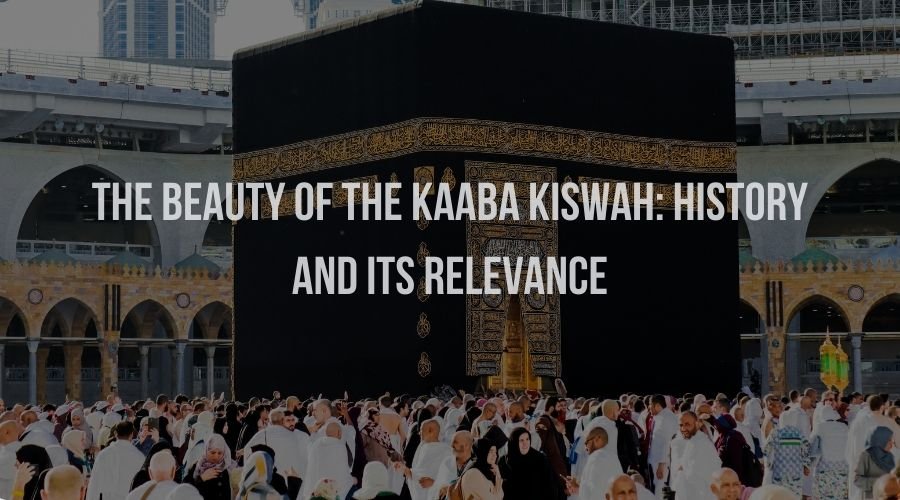Kiswah is the holy piece of cloth that is used to cover the holy stone building “Kaaba” in Mecca. According to Islamic traditions, every year, this embroidered cloth is changed on the 9th day of the month of Du al-Hijjah, which is the month of Hajj.
A Short Description Of Kaaba Cover
This embroidered silk cloth is 46 meters long and 95 cm wide. It is a pure natural silk cloth dyed in black colour. The main three colours that are used in kiswah are black, golden and silver. The holy sentences like, “La ilaha illa Allah, ” and ”Allahu Jalla Jalaluhu” are written on the black cloth with golden or silver thread.
Surat Al-Ikhlas is written in the Qur’an in circles with golden threads on each four corners. These circles are surrounded by squares. Six verses of the Quran are also written in a separate form.
History Of Kaaba Kiswah
It is very complicated to describe the whole history from when the Kaaba is without Kiswah to the present time. Here we are mentioning some important incidents in Kaaba Kiswa’s history.
The Origin Of Kaaba Cover
Many Muslim people believe that the Kaaba was not covered with Kiswah until the reign of King Tubba Abu Karab Asad of the Himyarite kingdom. It is believed that King Tubba was the first person who draped the Kaaba with Kiswah. After that, it became the tradition of his successors and they performed it as a religious duty.
Changes in Kiswa During the Reign Period of Prophet Mohammad
It is usually believed that the Prophet Mohammad and Muslims did not indulge in the system of draping the Kaaba until 630 AD as the Quraysh people did not allow them for this honor. The replacement ceremony was not held till accidentally a woman set fire to the kiswah while performing the prayers. After that incident, Prophet Mohammad started covering the Kaaba with a piece of cloth from Yemen.
The Significance of Kaaba Kiswa
Kaaba is the heart of the Islamic World and it is visited by many Muslims in the yearly pilgrimage of Hajj. It has been demolished and rebuilt many times since its construction started and now it is admired as the most sacred place for muslims. Because of its high importance, the cloth that covers the Kaaba also has a high significance. It is the most important aspect to pay respect to the holy Kaaba.
Every year the lower part of Kiswa has been raised by three meters in preparation for the new Hajj season. As it gets replaced with a white cloth. This process of raising the kiswa takes place every year before the Hajj season because some pilgrims touch and pull the holy cloth while performing “Tawaaf” of the holy Kaaba. On the 9th day of the month of Dhul al-Hijjah, the new kiswa is draped over the holy structure.
The Making of Kaaba Cover
This cloth holds a high significance in Islamic culture. The making of the Kaaba cover is very delicate and requires a lot of patience. The making of Kaaba Kiswah is divided into five stages,let’s delve into it.
1. Dyeing:
Firstly, the cloth was soaked in hot water with soap, water and other elements for 24 hours. After the cloth turns white, it is dyed in different colours like green, black and red colours.
2. Weaving:
Earlier, people used traditional methods to weave cloth by hand. But as the time changed people adopted new methods, so the whole cloth was not weaved by hand. Only the delicate parts are weaved by experts.
3. Printing:
In the third step, all the designs and calligraphy that are going to be displayed in the Kiswah are carefully printed on the piece of cloth.
4. Embroidery:
This is the most difficult and time-consuming step in the Kiswah making process as it requires a lot of experience and patience. All the calligraphy and designs are woven into the cloth with golden and silver thread with the utmost care.
5. Preparations:
In the final step, all four corners of the Kaaba cover are coordinated to show the design and verses at their proper place.
Some Fascinating Facts About Kaaba Cover
- Every year, the Kaaba cover is cut into smaller pieces and given to the dignitaries to give honour to them. Some pieces are also given to the pilgrims.
- The Kaaba cover contains around 46 pieces of cloth that are stitched together to form a 658-meter-long cloth.
- Kaaba cover costs can vary, but the approximate value is 22 million SAR (around 6 million US dollars).
- The cloth for kiswa came from different countries such as Iraq, Egypt, Baghdad and Yemen.
- The time of changing the kaaba kiswa has been changed from 10 Dhul Hijjah to 9 Dhul Hijjah.
- It is made up of 670 kg of pure silk.
- Around 220 kg of gold and silver thread are used to embroider Quranic Verses.
- The making of kiswa requires 140 experienced workers for eight months. More sophisticated machinery is used to speed up the process of kiswa making.
This is how the kiswa is made, Kaaba kiswa is the most devoted breathtaking sight at Masjid Al-Haram.




